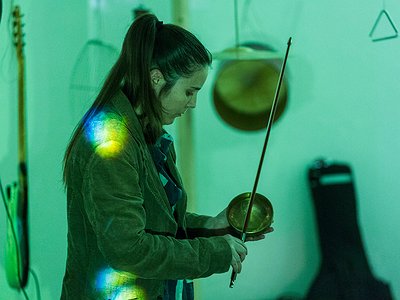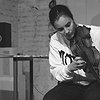Part 1
Name: Manja Ristić
Nationality: Serbian-Croatian
Occupation: Violinist, sound artist, curator, researcher
Current release: Manja Ristić's Water memory – mnemosonic topographies of the Adriatic is out now. She also has a new album, Awakenings, out on Richard Chartier's LINE imprint.
Recommendations on the topic of sound: Check out Florilegio, a blog / network of wom人n** musicians in the realm of experimental and underground music sharing points of views, stories, passions and more.
It is very hard to pick a single book for a such vast topic, so I suggest to readers: dig into the Bibliography of the writing I did for Cona Institute back in 2020 – "Introduction to sound & listening as psychoenergetic agencies."
The wonderful sound movie Metamorphosen by Jochen Fassbender is coming out soon.
A bit of science perhaps – "Determinants of Faraday Wave-Patterns in Water Samples Oscillated Vertically at a Range of Frequencies from 50-200 Hz"
[Read our Richard Chartier interview]
If you enjoyed this Manja Ristić interview and would like to know more about her music, visit her official homepage. She is also Instagram, ello, Facebook, and Soundcloud. For an even deeper dive into her work, we recommend our earlier Manja Ristić interview.
Can you talk a bit about your interest in or fascination for sound and what sparked it?
I suppose the accumulation of the abstract musical content I was exposed to during my teenage years, which I spent deeply submerged in classical music, did something to my cognitive development, eventually resulting in a very early dedication to violin performing. By the age of 15, I was obsessed by great classical composers, and I studied and listened to the classical music of all epochs thoroughly.
But then when I was 16, I visited my aunt in London, and walked by a music shop that had John Cage’s Violin Sonata sheet music exposed in the window. I had never heard about it. I swear I could hear a sound just by looking at that thin closed book. In time, I started realising that the sound I “hear” is not exclusively a product of an external stimuli. It was also a consequence of an early development of inner hearing, which was a necessary ability for professional violinism, but also on the side, evoked affinities for composing and exploring beyond conventional instrumental techniques as well as future experimentation with electro-acoustics.
Inner hearing built my inexhaustible musical curiosity. I believe that an early realization that I can hear beyond physical space triggered my future devotion to researching subtle layers of sonic strata. I was lucky to receive an education that helped me develop a particular musical intuition and a solid musical mind.
What have been some of the most beautiful/intriguing sounds you've heard and some of the most beautifully/intriguingly sounding places you've been to?
I always get a truly uplifting feeling when I encounter spherical spaces, as well as halls with a long reverberation.
Some of the recent encounters of such kind I had in the abandoned submarine tunnels of the ex-Yugoslav army on the island of Vis, and another similar one when I accidentally discovered the 1-kilometer long pedestrian tunnel Grič in Zagreb.
I also thoroughly recorded the abandoned mega-structure Stožice in Ljubljana. I recorded one of my all-time favourite albums in the old Turkish Bath in Belgrade, under its spherical domes and large derelict pools in collaboration with Serbian cellist and Tai Chi teacher Ivana Grahovac.
The acoustic density of those places fascinates me, and their thick memory fields too. All of these are historical heavyweights, except for Stožice which is part of the most recent history and is slowly turning into a Third landscape, a concept I explored in the work Sonic Ontology of Negligence.
But in the last decade, I admit I am hooked on exploring subtleties of underwater sounds and places with unusual terra-sonics (sounds of sediments, movements of the sea bed, riverbeds, ponds, etc.). The Adriatic sea flora and fauna are my present focus and listening passion and I get very excited when I stumble upon a new sound underwater.
Limestone litophony is also a huge part of discovering the sonic simulacra of the Adriatic litoral belt, and the interaction of the crystalised volcanic coast and the constant movement of the sea (caves, blowholes, micro-topographies). The work of the late sculptor from San Sperate in Sardinia, Pinuccio Sciola triggered in me a deep fascination with the sound of stone. The sound that blew me out of my shoes some 20 years ago was the compilation Hearing Solar Winds by David Hykes.
And since then I am always deeply moved when I hear the sound within the sound, so to speak, hidden harmonics or non-obvious traits of a particular, space, object, or instrument. I used to get very excited every time I discovered a new sonic texture on the violin while I was extensively exploring extended techniques. That drove me to develop the Violin Revealed notation system. The quirkiest and funniest sound I encountered recently was a blowhole sounding like a person with a clogged nose, a sniffing rock I found under the fortress walls of Korčula town.
Still, with all this affinity in searching for the sounds, what is the most rewarding for me are empty spaces, and places stripped of obvious sound sources, because there is a great deal of sonic content left within them that reveals itself with careful observance.
The human voice is one of the first sounds we are exposed to, even before we understand the exact meaning of words. Are you, too, interested in voices and language, the rhythm of speech, the timbres of different voices – and do you think these qualities find their way into your sound work?
Yes, of course, I am deeply fascinated with many aspects of language. “Language is a virus”, to refer to Burroughs and quote Laurie Anderson! Poetry is very important to me, phonetics of different world languages and semiotics too, and I have even been researching the cognitive development of early humans, as I was curious about the evolutionary moment when language first occurred.
But to be honest, the older I am, the more I am interested in the “weirdness” of language. Vocal and graphical experimentation. Visual and aural decomposition. I dig into a language as a concept, an abstract set of rules that represent a person’s ability to communicate deeper emotional and intellectual content.
In contemporary society, a voice reached the point of becoming a manipulative tool, which inevitably opens the anxious discourse of the politics of voice. If I use language in my work, it has to have roots in poetic constructs, and if I use my voice – even if it is just a breath, I make it into a language of my heart and soul. That is the situation for now at least.
There can be very deep/high/loud/quiet/grating/delicate sounds and many more. Are there extremes in sound you are particularly interested in – and what response do they elicit in you?
I wouldn’t say I have a particular interest in extremes, who am I to discriminate among sounds! But I am deeply attracted to non-obvious sonic events and hidden sonic traits of objects and spaces. I am interested in their energy potentials, geometry, and their co-dependent energy exchange within the space in which they (sounds) occur.
But it would be unfair to say that the delicacy of the sound is not important to me as well, I put a great deal of effort into balancing the overall sound picture with the aim of reducing harmful frequencies. When something sounds harsh in my music that is fully intentional, and it means I want a listener to feel discomfort. Not because I am evil, but because there would be no conscious listening without dynamics.
When I say conscious listening, I mean – a listening experience that has the capacity to communicate abstract content beyond aesthetics, and the capacity to produce energy exchange that has transformative potential. Emotionally, intellectually, and sometimes even spiritually.
Deep listening, audiowalks, meditation, listening with both eyes closed, and the like can sharpen our sense of hearing – which techniques or experiences have worked for you to create a greater awareness of the sound aspects of music and our environment?
Extensive classical music training, extensive meditation, extensive training in phenomenological psychology, and an enormous amount of hours, days, weeks, months, and years of listening. Discipline and dedication. Deep listening is presently a very popular phrase and I think should be always pointed out as a lifelong legacy of the brilliant and inspiring Pauline Oliveros.
[Read our Pauline Oliveros interview]
My standpoint is that listening is an essential evolutionary aspect of all-pervading nature, and not exclusively a human-invented social construct. Meaning – while you are listening to nature, nature is listening back. Evolution is listening. Listening is evolution. The means of it though are diverse from environment to environment, from system to system.
There are many traces of ancient civilisations, some of which were so delicate when it comes to architectural acoustics, that display proof of listening being something highly important, even sacred. Listening is a complex and systematic occurrence in nature, and fortunately, human psycho-physical capacities are quite limited. Otherwise it would be impossible for us to exist in the cosmic noise in which we are soaked. The universe is a very noisy place. Our Planet is a very noisy place. Same as every species, we are blessed with a hearing range that suits our systematic psycho-physical development.
I personally lean a lot onto my body while listening: skin, relations between my extended body and resonance, changes in pressure ... While the physical properties of a sound with all of its particularities are becoming absorbed, the mind is tuning into a specific state – the mind being a cognitive hub holding all ends of perceptive but also creative processes, emotional responses, psychological recognition, attention categorisations, and such.
The most banale description would be that this approach has some transcendental aspects. But it digs deep into intuitive aspects of the body as well.






